Key takeaways:
- Integrating fun activities with curriculum content enhances student engagement and emotional connection to learning.
- Balancing academic rigor with enjoyable experiences fosters creativity, critical thinking, and a love for learning.
- Gamification, storytelling, and hands-on activities significantly improve retention and understanding of complex subjects.
- Encouraging student participation through a supportive environment and humor enriches the educational experience.
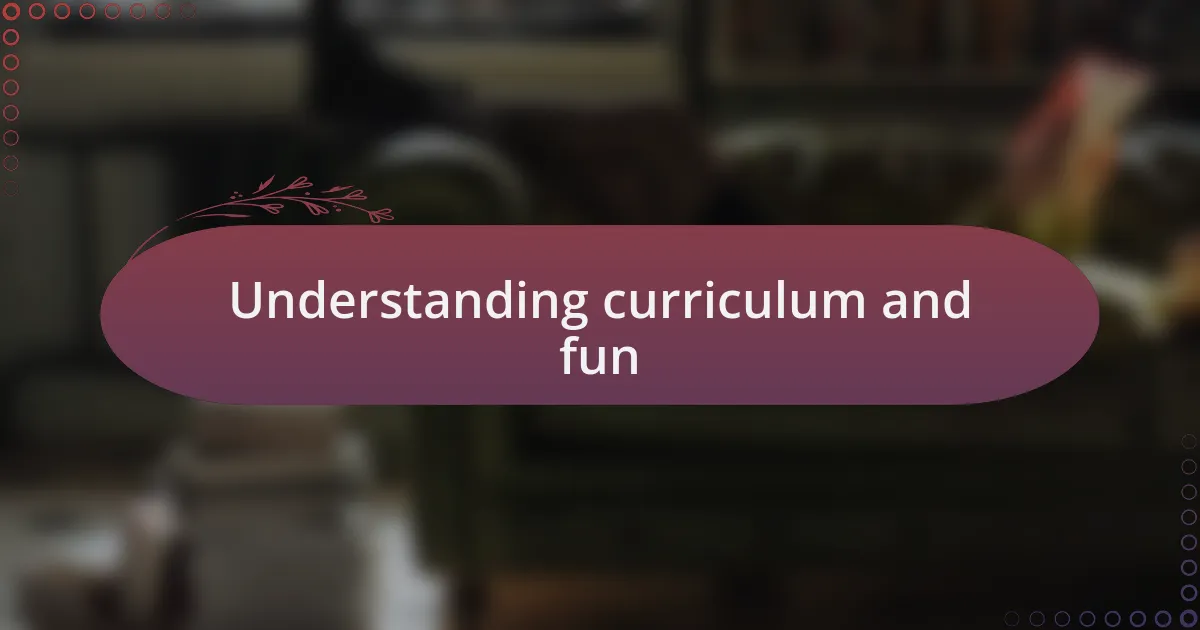
Understanding curriculum and fun
Understanding the balance between curriculum and fun is essential in creating an engaging learning environment. I often find myself pondering how play can coexist with structured learning. It’s fascinating to realize that fun can enhance understanding, making lessons memorable and enjoyable.
In my experience, integrating fun activities with curriculum content not only keeps students engaged but also fosters a deeper emotional connection to the material. I remember a science project I introduced, where we created a mini-garden to learn about ecosystems. The laughter and excitement created a lively atmosphere, allowing students to grasp complex concepts effortlessly.
Have you ever noticed how a simple game can spark curiosity? I’ve implemented quiz games that not only assess knowledge but also inject a spirit of competition. Students often recall facts better when they’ve experienced the subject through playful interaction, reinforcing the idea that learning doesn’t have to be dull—it can be an adventure filled with exploration and discovery.
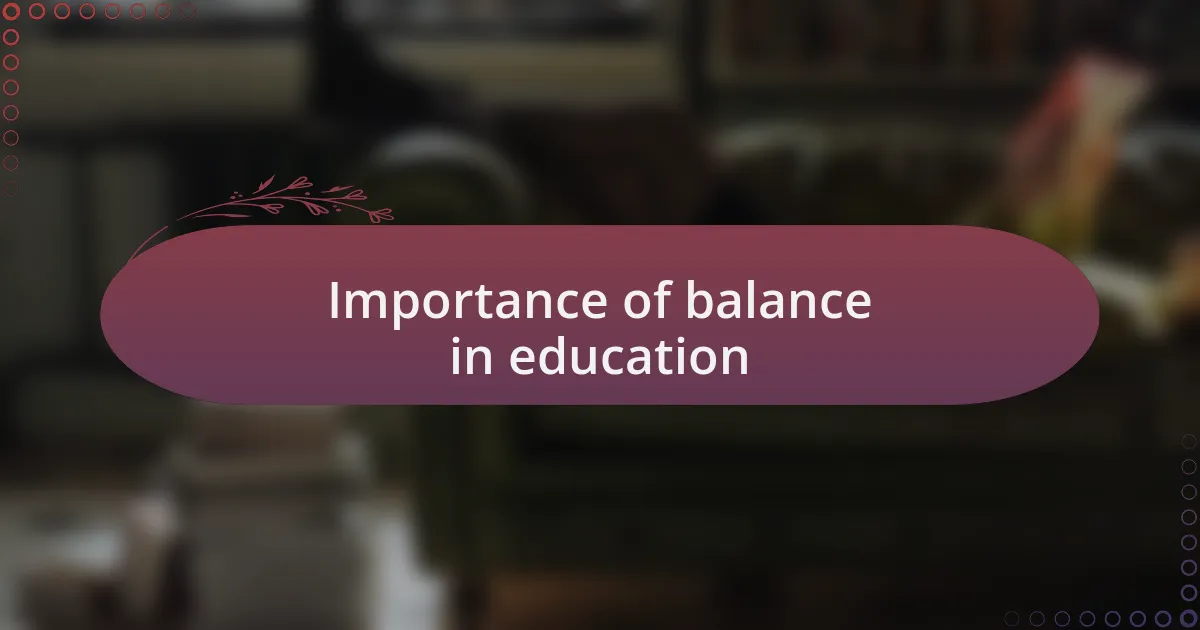
Importance of balance in education
Finding a balance in education is crucial for fostering both academic excellence and personal growth. I’ve seen firsthand how students thrive when their emotional needs are met. For instance, during a math lesson, I encouraged a collaborative puzzle-solving game. The joy radiating from my students as they worked together made the math concepts stick far better than any lecture could.
Moreover, a well-balanced educational experience helps nurture creativity and critical thinking. I often reflect on art projects where students integrated math principles, like geometric shapes, into their designs. It was incredible to watch them light up, transforming skills into unique expressions. This not only reinforced their understanding but made the learning process more rewarding.
Sometimes, I ask myself: what if education focused solely on rigid standards without consideration for enjoyment? My observations tell me that such an approach can lead to disengagement. When students find joy in learning, they become lifelong learners, eager to explore new ideas rather than simply check boxes on a syllabus. Balancing curriculum and fun creates a learning environment where challenges become exciting opportunities.
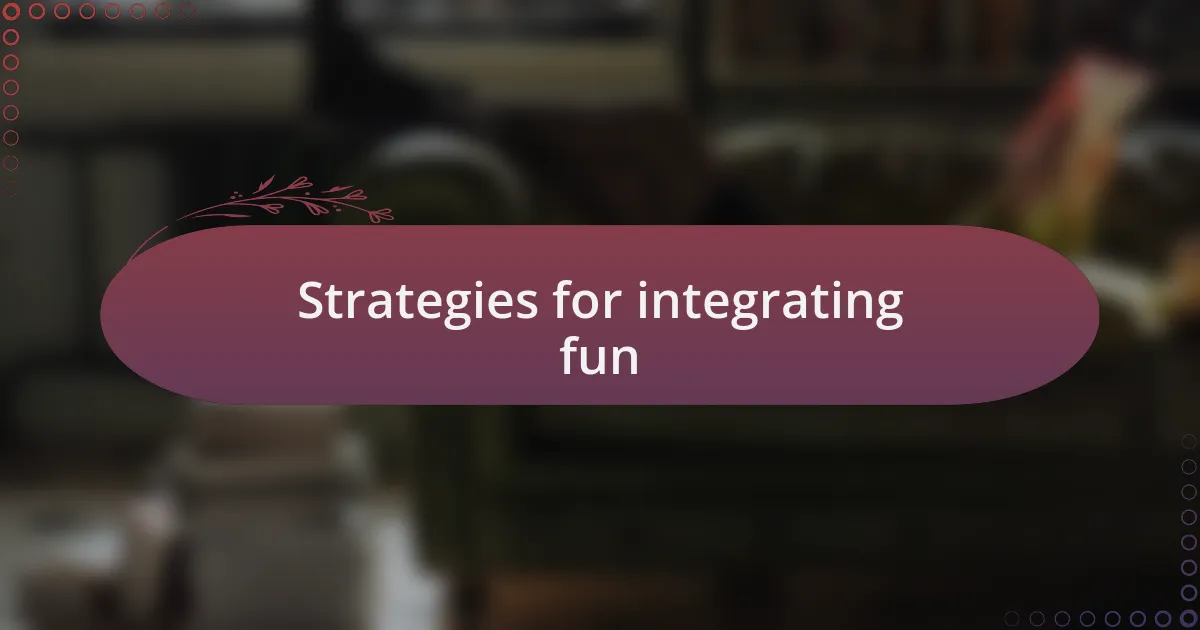
Strategies for integrating fun
One effective strategy I’ve adopted is gamifying lessons. I remember when I incorporated a trivia game into a history unit. Students participated with such enthusiasm, answering questions while racing against the clock. The energy in the room transformed, and I noticed not just engagement but a deeper retention of historical facts they typically struggled with. Why is that? Because when learning feels like a game, anxiety diminishes and curiosity flourishes.
Another approach is to leverage storytelling. I often create narratives around dry concepts, such as turning a science lesson into an adventurous journey through the human body. By personifying cells as characters with distinct roles, I could see my students’ imaginations ignite. It allowed them to connect emotionally with the material, making abstract ideas feel concrete and memorable. Have you ever noticed how a good story can linger, long after the details fade?
Lastly, hands-on activities can be a game changer. I vividly recall a science week where students designed their own experiments. The room buzzed with excitement as they mixed materials and documented their findings with genuine curiosity. In those moments, the line between fun and learning blurred beautifully. Doesn’t it make sense that when students actively participate, they feel a sense of ownership over their learning? It turns their education from passive reception into an engaging exploration.
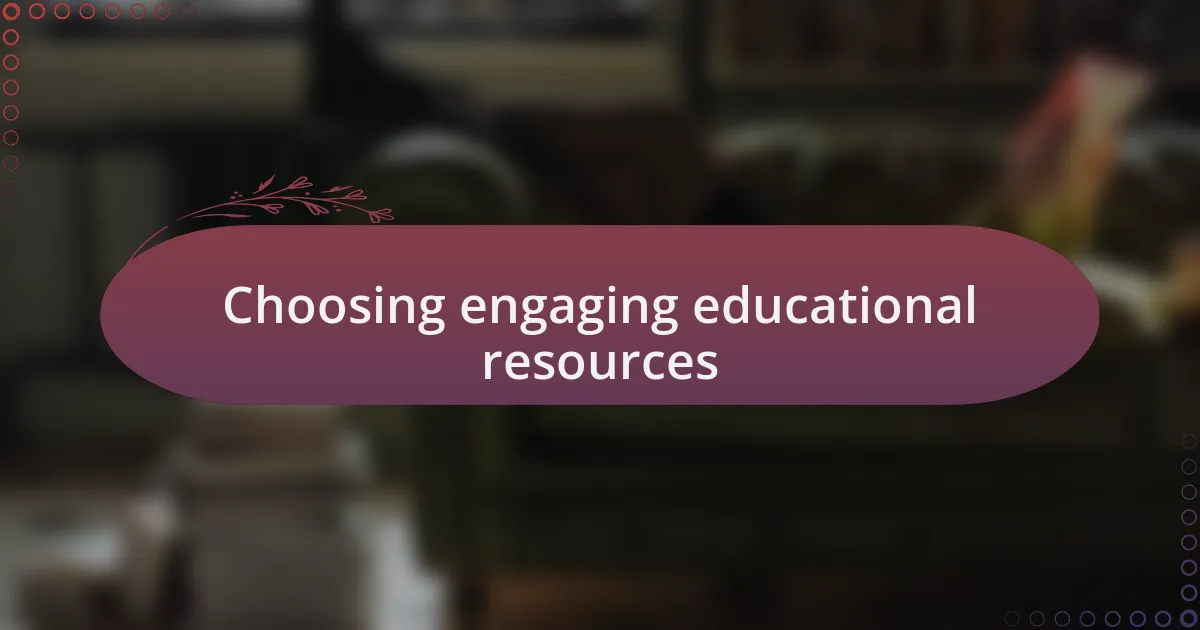
Choosing engaging educational resources
When selecting educational resources, my first step is to consider their interactivity. I remember a particular math app that encouraged students to solve puzzles in a fun, engaging way. Not only did it provide instant feedback, but it also allowed students to collaborate, fostering a sense of community. Have you ever noticed how tools that invite interaction can transform learning into a shared experience?
I also focus on visual appeal when choosing resources. One time, I came across a beautifully designed science textbook filled with captivating illustrations and infographics. It wasn’t just informative; it drew my students in and made them want to explore further. This experience reaffirmed my belief that aesthetics matter in education. Don’t you think that when materials are visually stimulating, they can capture attention and ignite curiosity?
Moreover, I always seek out resources with diverse perspectives and inclusive content. I vividly recall using a series of videos featuring scientists from various backgrounds sharing their stories. This not only provided relatable role models but also opened up discussions on representation in science. Engaging resources should reflect the diverse world we live in, prompting students to see themselves in the material. Isn’t it essential that learning materials resonate with every student, making education feel accessible and relevant?
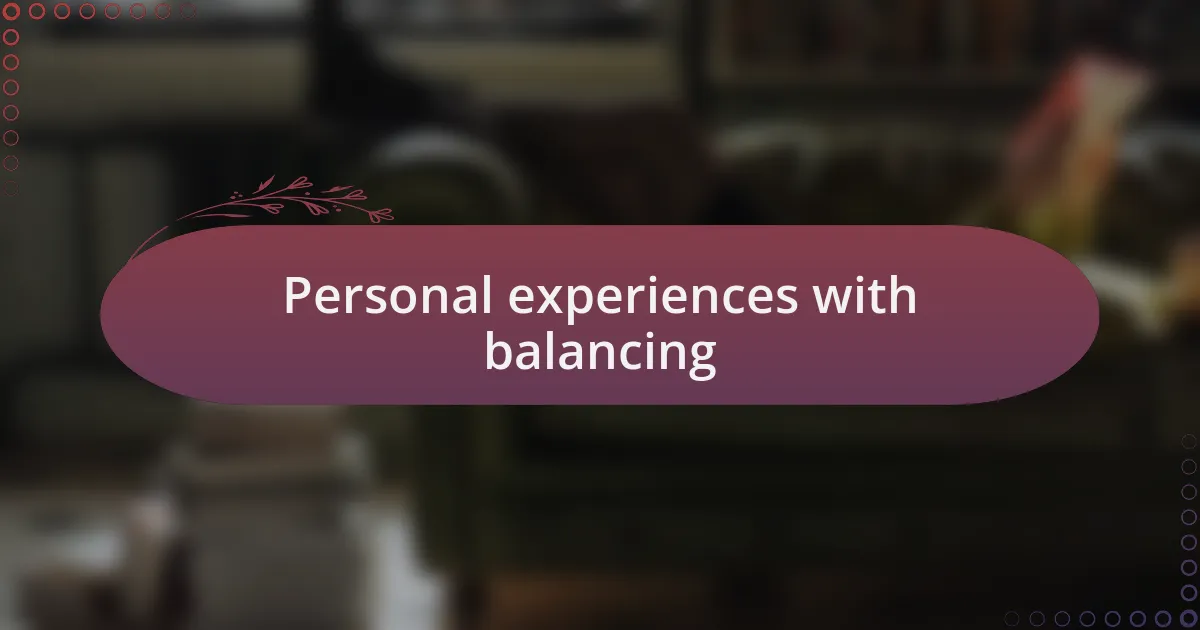
Personal experiences with balancing
In my experience, striking a balance between curriculum demands and fun has often felt like walking a tightrope. Once, during a particularly intensive review week, I introduced a game-based learning approach. I was amazed to see one student, who usually struggled with engagement, light up during a math competition. It made me ponder: could fun truly enhance motivation and learning?
I remember creating a science project that allowed students to select their own topics, driving both interest and ownership. I felt a sense of pride watching them dive headfirst into their chosen subjects, showing creativity I hadn’t anticipated. This experience led me to wonder: when students have a say in their learning, are they more likely to retain what they learn?
Balancing the curriculum with enjoyable activities necessitates constant reflection. There was a time when I tried to cram too much content into a short class, and it fell flat. The students looked exhausted rather than excited, which gave me pause. I realized then that it’s essential to intersperse lessons with moments of joy and interaction. It made me think about how we, as educators, can nurture a genuine love for learning amid the necessary curriculum structure.
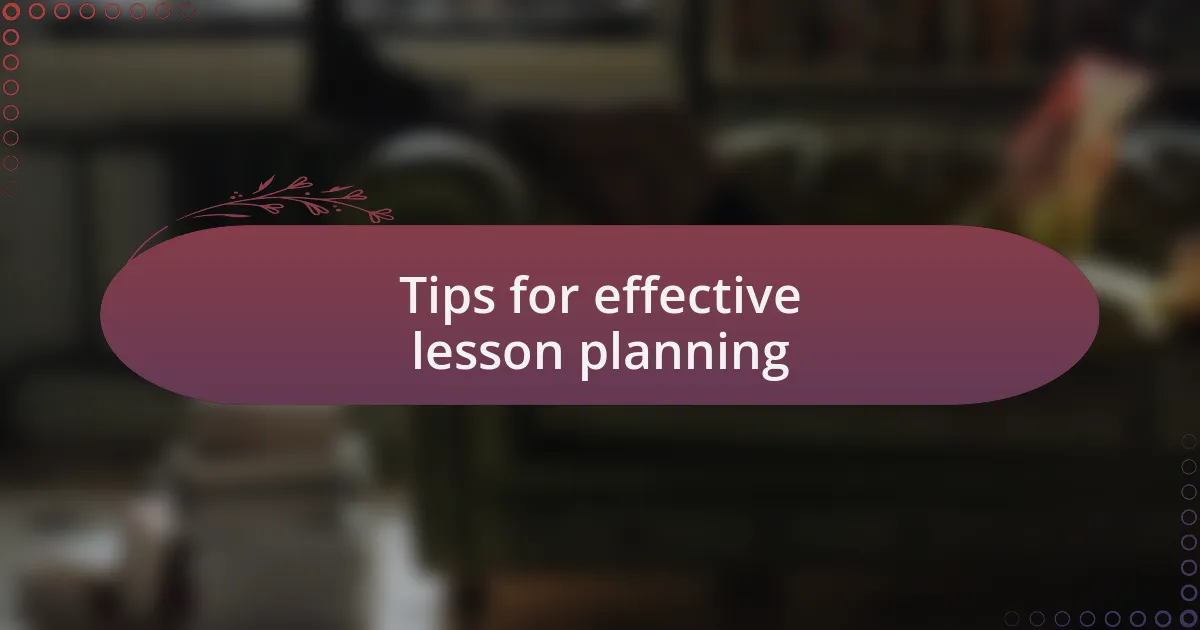
Tips for effective lesson planning
When planning a lesson, I’ve found that setting clear objectives makes a world of difference. For instance, one time I aimed to teach fractions through a cooking activity. By clearly defining the learning expectations, the students not only followed the recipe but engaged in meaningful discussions about the math behind measurements. It sparked my curiosity: could the right structure really unleash deeper understanding?
Incorporating varied teaching methods is key to effective lesson planning. During a history unit, I decided to introduce a role-playing element, allowing students to step into historical figures’ shoes. Seeing them debate and discuss as if they were living in that era transformed the classroom atmosphere. It left me wondering: how often do we let students experience lessons rather than just consume them?
Finally, I believe that flexibility is crucial in lesson planning. I recall a day when I intended to teach a complex topic but noticed puzzled looks from my students. Rather than pushing through, I shifted the plan and introduced a hands-on exploration instead. This reminded me that sometimes, adapting to the moment is the best way to ensure that learning actually happens. Could being responsive to student needs enhance their educational experience? I think so.
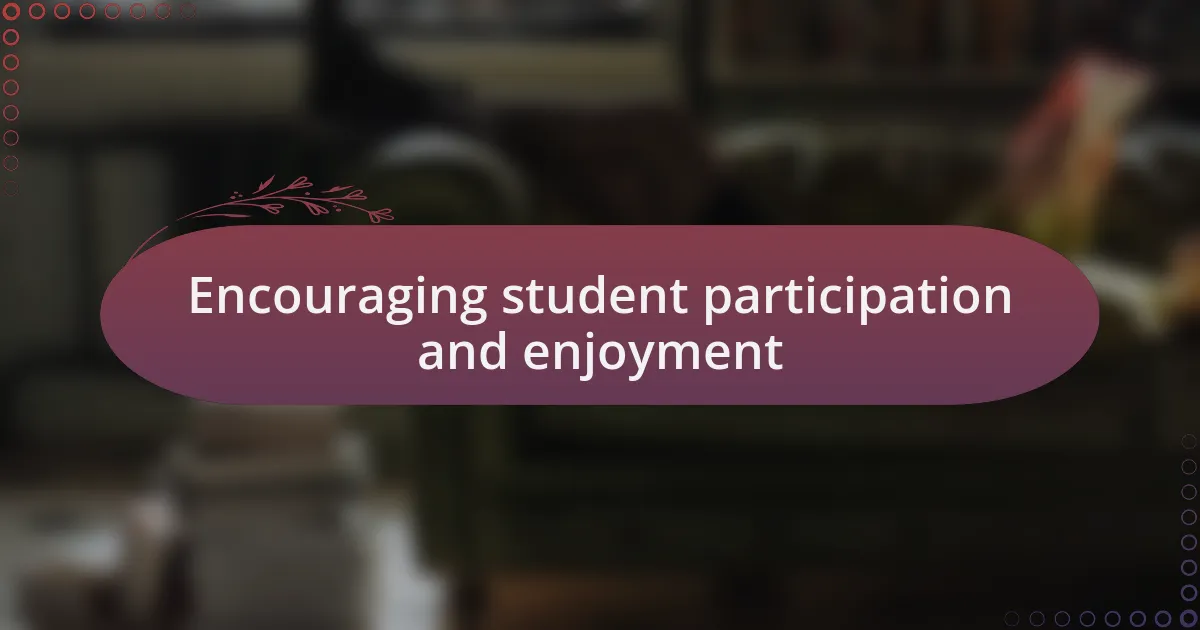
Encouraging student participation and enjoyment
Encouraging student participation often starts with creating an environment where opinions and ideas are valued. I remember a time I implemented an open forum at the end of each week where students could share their insights about the topics we covered. It was heartwarming to see the pride on their faces as they expressed themselves, and it made me realize: how much value do we place on student voices in our classrooms?
Hands-on activities can really elevate both engagement and enjoyment. For instance, during a science lesson on plant biology, I set up a mini-garden project where students could plant seeds and observe their growth over time. The excitement was palpable as they watered and cared for their plants, transforming a simple lesson into a memorable experience. This raised an interesting thought: could the act of nurturing something living lead to deeper learning and appreciation for science? I believe it can.
I’ve also found that humor goes a long way in fostering an enjoyable learning atmosphere. Once, while teaching grammar, I decided to create a silly skit around punctuation marks. The laughter we shared not only made the lesson more effective but also encouraged quieter students to join in and express themselves. Isn’t it fascinating how joy can break down barriers and spark participation? It seems that a little laughter might be just the ingredient needed for an engaging classroom.